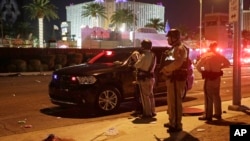Studies show mass killings have tripled in the past few years. A massacre Sunday night in Las Vegas left 59 people dead as a gunman in a hotel fired upon thousands of people below who were attending a music festival.
Until that tragedy, last year's shooting at an Orlando nightclub was the deadliest in U.S. history. Forty-nine people died when a gunman opened fire on club-goers. In 2012, a gunman opened fire at an elementary school in Newtown, Connecticut, killing 20 children between the ages of 6 and 7 years old, as well as six others, including the shooter's mother and staff and teachers at the school.
Watch: Profile of mass killers
Mass killers used trucks filled with fertilizer to create an explosion that left 168 people dead at the federal building in Oklahoma City in 1995. The land is now filled with empty chairs, each etched with the name of one of the victims.
That was the worst mass killing until September 2001, when killers crashed airplanes into The World Trade Center's twin towers in lower Manhattan. As in Oklahoma City, the ground where the towers once stood is now a memorial.
Profiling mass killers
J. Reid Meloy, a forensic psychologist, said mass murderers "typically have more in common" with each other than not.
He said the killers tend to have a history of psychiatric problems, are mostly men, and have rocky intimate relationships.
Meloy said the killings are a quest for status and usually are not, despite killers' claims, rooted in a cause.
"Oftentimes, the pathway to violence begins with a personal grievance," Meloy said. "It typically has three components to it. One is there's some kind of loss. Secondly, there's the feeling of humiliation. Then thirdly, there's anger toward and blaming of a person or a group of people who have caused them to have this problem."
Access to weapons is one factor, but social media is another.
Meloy said social media makes killers notorious and, when an attack is shown online, those seeking notoriety decide to imitate the atrocity and gain notoriety for themselves.
It is an appeal that, unfortunately, Meloy predicts will spawn even more mass killings.













